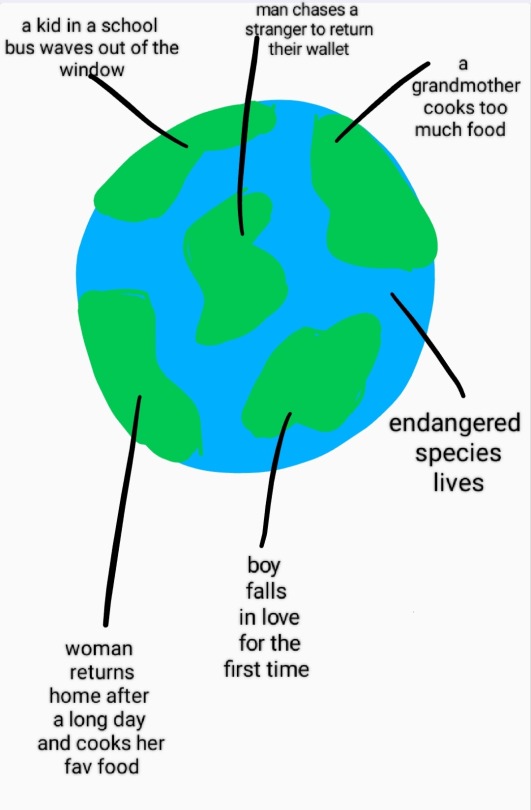Text

Killdeer . . . Cupola Park, Millsboro, Delaware . . . 3/8/24
109 notes
·
View notes
Text

[2685/11080] Coppery metaltail - Metallura theresiae
Order: Apodiformes (swifts and hummingbirds)
Family: Trochilidae (hummingbirds)
Subfamily: Lesbiinae
Photo credit: Peter Hawrylyshyn via Macaulay Library
369 notes
·
View notes
Text
My biggest pet peeve about sustainability discourse is that, yeah, a handful of companies are fucking us all over, and yeah, we need fundamental change coming from the government. But also you need to understand that you can't have both things:
You can't have zero single use plastic and only sustainable materials and expect to be able to afford brand new clothes every month.
You can't have an increase in workers rights protections and expect to still get things you order online delivered to your house in a couple of days.
You can't have meat production reduced to the point where it's not environmental destructive and expect to be eating meat more than a couple times a week at most.
We NEED big scale change but that WILL significantly affect your lifestyle. You need to stop living in a fantasy world where fast fashion prices or eating animal products daily can ever coexist with sustainability.
513 notes
·
View notes
Text

this is a total normal thing for ANOTHER COUNTRY'S foreign intelligence agency front to say to American university students who are peacefully demonstrating against the genocide and oppression of Palestinians
7K notes
·
View notes
Text




Onondaga
📷: @sjscoyote , 2010
📍: Onondaga Cave State Park, Missouri
1K notes
·
View notes
Text
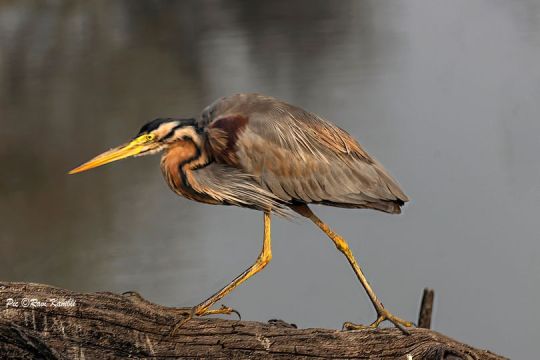
Purple Heron (Ardea purpurea), family Ardeidae, order Pelicaniformes, Bharatpur Bird Sanctury, Rajasthan, India
photograph by Ravindra Kambli
720 notes
·
View notes
Text

If you dare come at me about banning straws, I will throw you into the sun cannon. I’m disabled, I’m crippled, I need disposable plastic straws, and all those pricey ridiculous alternatives aren’t working as well. Plastic straws were invented for the disabled.
Way to shit all over a vital access need because you think straws are worse than corporate greed.
We all care about the turtles, the seals, the oceans, obviously. Notice how the easiest thing to yell about was something that would barely affect anything but appealed heavily to emotional discourse.
The disabled community is huge, and it can be joined by anyone. Most of those As Seen On TV products were invented for us. Society still mocks us and ignores us, and often outright harms us in multiple ways.
Communicate better. Listen better. But stop putting us out in the cold because you are inconvenienced by our simplest needs.
214K notes
·
View notes
Text








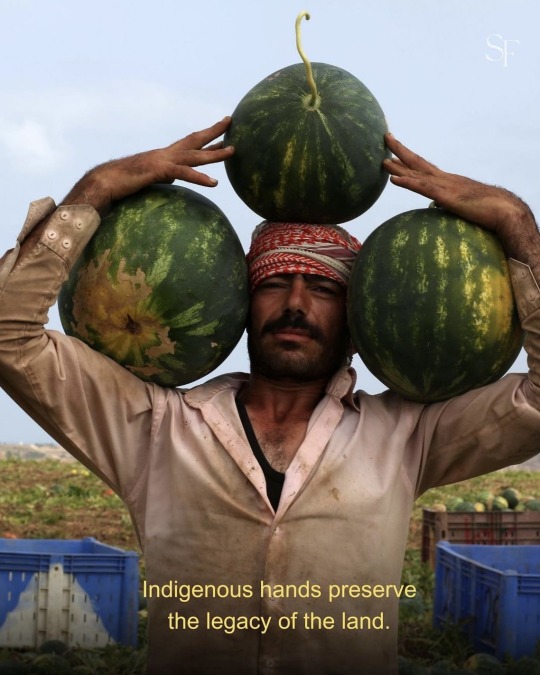

@/savoirflair: On #EarthDay, it's crucial to recognize that the guardians of our planet are its indigenous peoples, who have historically maintained biodiversity and preserved natural resources through deep-rooted practices and ancestral wisdom. There is no climate justice without human rights, and we cannot celebrate our planet without honoring its original and eternal custodians. Without the stewardship of indigenous populations like the Palestinians, our environmental efforts are incomplete. Their resilience and ongoing struggle underline that Earth Day is not only a call for environmental action but also for justice and the recognition of the rights of indigenous guardians who have nurtured the land for centuries.
3K notes
·
View notes
Note
Do you consider brachycephalism in cats as serious as in dogs? I'm in veterinary medicine but I don't encounter many brachy kitties and would love to hear your thoughts on it.
Brachycephaly is a problem.
Schlueter et al (2009) categorized brachycephalic head shapes into four categories randing from mild to severe.

Moderate brachycephaly is where we begin to really see problems and profound or severe brachycephalic cats are going to have a real issue.


The British Shorthair (left) is a breed where mild brachycephaly is part of the standard compared to an Exotic Shorthair (right) where profound - severe brachycephaly is desireable.


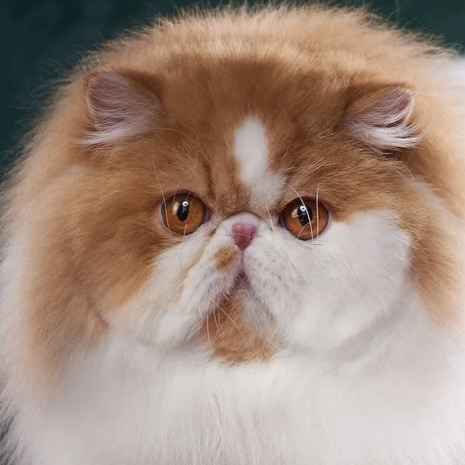
On the left with have a British Shorthair, in the center an Exotic Shorthair and on the right a Persian.
One of the problems we see with brachycephalic breeds is stenotic nares, which are narrow nostrils. You can’t even make out the nares on the Persian shown above and, as one may expect, this affects how much air they move through them.
We can see similar obstructive effects in cats with nasopharyngeal polyps, masses or reconstruction due to scarring from chronic rhinosinusitis problems.
Due to their inability to breath normally through their nose these cats tend to be heat and exercise intolerant and can run into trouble more quickly during high stress events.
Stenotic nares can be surgically corrected but I don’t think this is as common in cats as it is in dogs, at least I haven’t encountered many cats who’ve undergone the procedure. I don’t know if it’s not as necessary, if cats don’t respond as well or if cat owners are less likely to seek treatment.
Or maybe it is as common and my lack of experience is the outlier.
Brachycephaly is also associated with malocclusion and dental disease, chronic epiphora, facial dermatitis related to the chronic tearing and ocular issues such as conreal sequestrum or entropion related to the protruding eye structure.
I know globe proptopsis is a problem in some brachycephalic dog breeds like pugs but I haven’t heard of this specifically happening in brachycephalic cat breeds.
Exotics and Persians are obviously the worst when it comes to brachycephaly in cats but the Bombay and (American) Burmese are also offenders.
There are other breeds which don’t call for a brachycephalic head shape (or even default it) or call for only a mild version but certain breeders are selecting for extreme typeing anyways because even though their cats might not win any shows they can sell them as designer variants for more.


On the left we have a Sphynx and in the right we have a Devon Rex both with an extreme head type contradictory to the breed standard.
So yes, unfortunately the brachycephalic head type is a problem in cats. Some try to argue that brachycephalic animals often live long lives which means the abnormal structure isn’t a problem… but longevity is only one measure of a breeds ethical soundness, quality of life and history are also important in my opinon.
2K notes
·
View notes
Note
Hi! I’m currently working on a big, detailed Blackfish rebuttal, which means lots of rabbit holes. I recently started rereading John Hargrove’s book (ugh). He talks about how the original Shamu died of pyometra and septicemia, claiming that it was something that, apparently, would almost never happen in the wild. The obvious implication here is that captivity caused these conditions, and/or that such is common with captive orcas. However, obviously septicemia can be caused by a variety of things, wild or not. As for pyometra, he doesn’t provide other examples of captive orcas suffering pyometra, nor have I been able to find other examples described in peer reviewed literature. It seems that that isn’t particularly common in cetaceans period, whether they’re wild or not, but I’m also not a marine mammal veterinarian. Since you’d know better about cetacean medicine, I was wondering if you knew anything more about this.
Ooh, that'll be interesting! I'd love to read it!
You're correct that Shamu is the only reported case of pyometra in a killer whale, wild or captive. The CRC Handbook of Marine Mammal Medicine makes no mention of pyometra in cetaceans, although it does occur in both wild and captive pinnipeds and has been reported in sea otters and sirenians. Pyometra is typically the result of bacteria migrating up the vaginal tract into the uterus, which at certain times is more susceptible to infection due to normal hormonal fluctuations. Theoretically, anything with a uterus can get pyometra, though some species are more commonly affected than others.
I would hedge to bet that pyometra is rare in cetaceans because of their truly unusual reproductive anatomy. Females have a lot of redundant tissue in their vaginal tract, creating "false cervixes" and overall making it a lot more difficult for anything to reach the uterus.
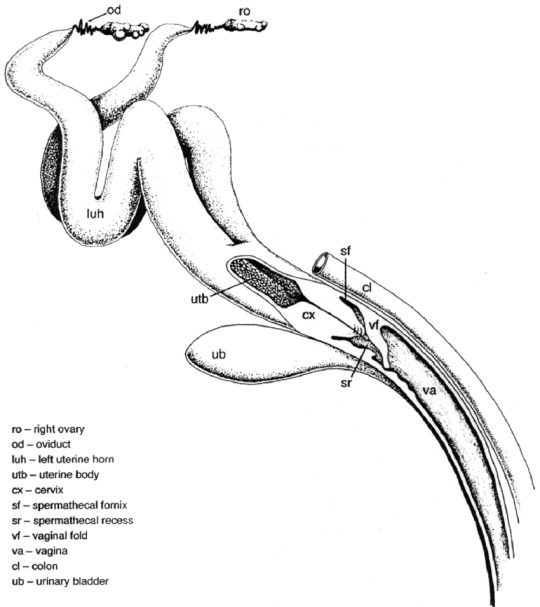
See all those extra recesses around the cervix?
I did find this case report on a necropsy of a wild short-beaked common dolphin. Pyometra was one of many nasty issues afflicting the poor girl, so it can indeed occur in nature. Since this individual was suffering from co-infections of bacteria and cetacean morbillivirus, she was clearly immunocompromised. It's highly likely Shamu was as well.
Overall, pyometra of cetaceans (including orcas) appears to be quite rare in both the wild and managed care. Shamu was the very first orca intentionally captured for public display, nearly 60 years ago, and only survived six years in captivity before her death at approximately age 10. Virtually nothing was known about killer whale husbandry at the time, so it's not at all unreasonable to assume that poor husbandry, nutrition, and stress negatively impacted her immune function to the point she succumbed to pyometra.
However, it's a weak argument on Hargrove's part to compare the SeaWorld of today (with multiple orcas now in their 30s, 40s, and 50s) to the SeaWorld of the 1960s, and their very first whale at that. Especially using a condition that has not been reported in a captive orca since.
37 notes
·
View notes
Text
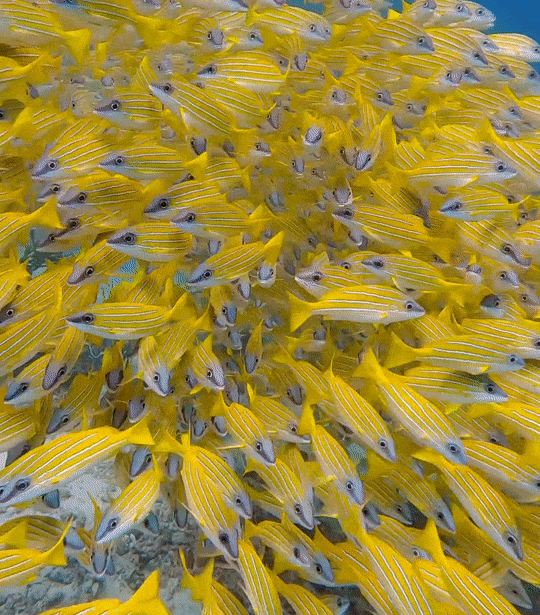
A school of Bluestripe Snapper in the Maldives.
°°••....••°°
Free to use with credit!
77 notes
·
View notes
Text
Unique adaptations allow wild animals to survive temperature extremes that would quickly kill an unprotected human. For example, certain animals can withstand bitterly cold weather, thanks to the insulating properties of the hollow hairs that make up their coats.
Little has been known about these hairs, but now researchers have discovered that their inner structure changes with the seasons. The researchers will present their results today (March 17) at the spring meeting of the American Chemical Society (ACS).
Continue Reading.
138 notes
·
View notes
Text
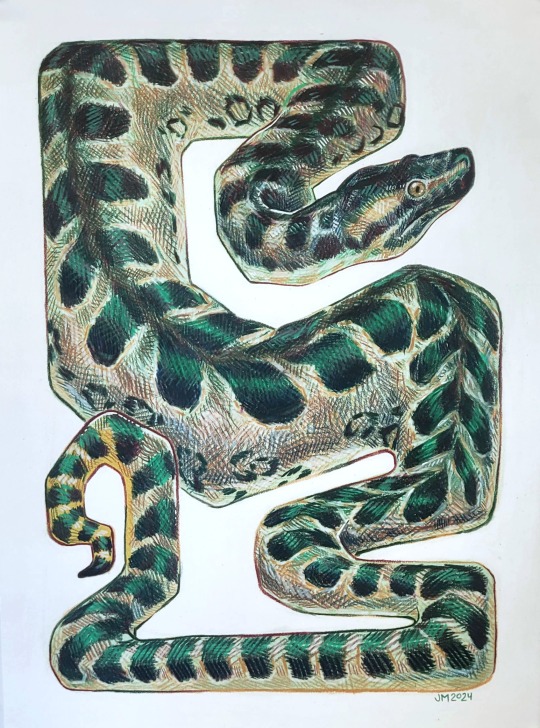
Working on a new series for a gallery show I'll be part of in May!
4K notes
·
View notes
Text

Shoebill (Balaeniceps rex), family Balaenicipitidae, order Pelicaniformes, Uganda
This bird is the only member of its family.
The taxonomic affinities of this bird have long been debated. It currently rests within the order Pelicaniformes. It was, in the past, often placed in the Ciconiiformes.
Its closest living relative is most likely the Hamerkop.
Photograph by Jon Luca Tognon
2K notes
·
View notes
Text
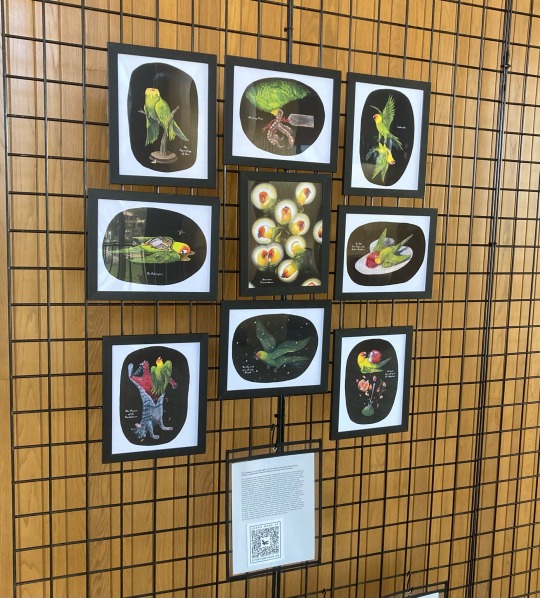
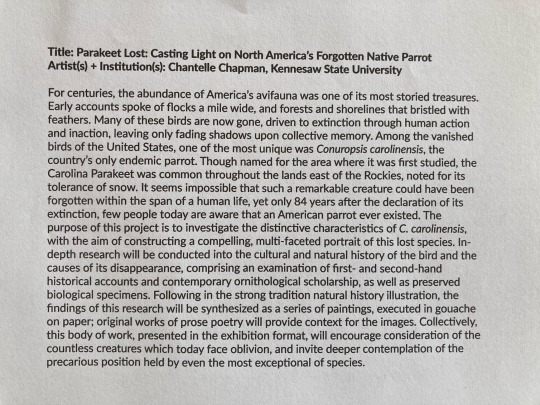

Currently presenting ‘Parakeet Lost’ in the visual arts gallery at the National Conference on Undergraduate Research in Long Beach, California, and getting a wonderful reception! Thank you to everyone who’s dropped by to learn more about Carolina Parakeets and bird extinction!
199 notes
·
View notes

